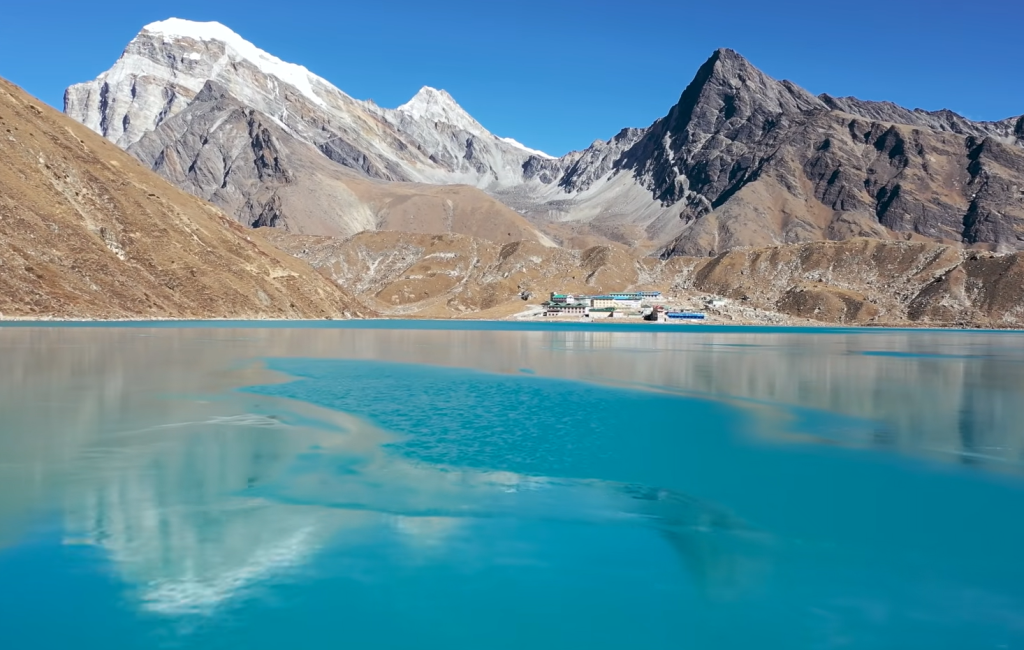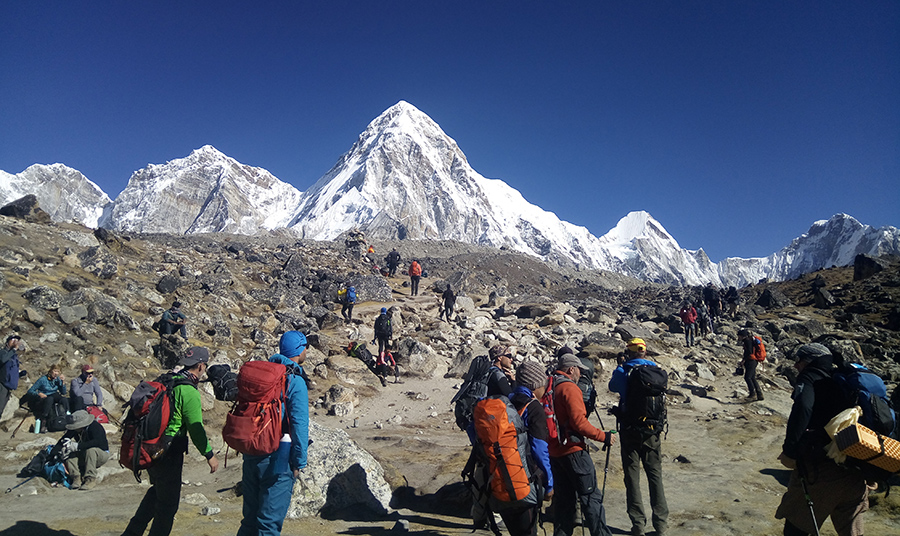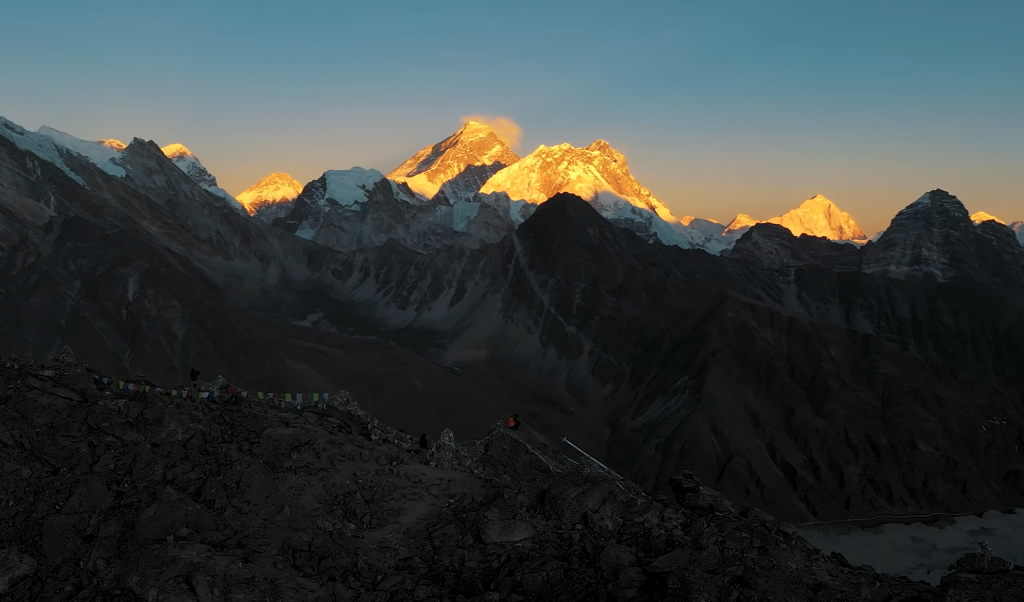September 17, 2023

The Gokyo Trek is a remarkable and less-crowded trekking route located in the Khumbu region of Nepal, renowned for its stunning landscapes, pristine lakes, and breathtaking views of the world’s highest peaks, including Mount Everest. This trek offers a unique and less-traveled alternative to the popular Everest Base Camp trek, making it an excellent choice for trekkers seeking a quieter and more remote experience in the Himalayas.
The trek typically starts in Lukla, where you’ll follow the same initial path as the Everest Base Camp trek before branching off towards the Gokyo Valley. As you ascend, you’ll pass through charming Sherpa villages, lush rhododendron forests, and serene yak pastures, immersing yourself in the local culture and traditions.
The highlight of the Gokyo Trek is the series of turquoise glacial lakes in the Gokyo Valley, the largest of which is Dudh Pokhari. The sight of these pristine lakes set against the backdrop of towering peaks like Cho Oyu and Gokyo Ri is simply mesmerizing and provides ample opportunities for stunning photographs.
One of the main attractions is Gokyo Ri-5383m, a viewpoint that offers panoramic views of four of the world’s 8,000-meter peaks: Mount Everest, Lhotse, Makalu, and Cho Oyu. The sunrise from Gokyo Ri is a magical experience that shouldn’t be missed.
The Gokyo Trek is considered moderately challenging, with its high-altitude terrain requiring proper acclimatization. Trekkers should be prepared for altitude-related challenges and changing weather conditions. However, the rewards of this trek, including its pristine natural beauty and a quieter atmosphere compared to the EBC route, make it a fantastic adventure for those seeking an unforgettable Himalayan experience.

Gokyo Lake in Everest Region
Day 1: Fly from Kathmandu to Lukla (2,840 meters / 9,315 feet) and trek to Phakding (2,610 meters / 8,563 feet).
Day 2: Trek from Phakding to Namche Bazaar (3,440 meters / 11,286 feet).
Day 3: Acclimatization day in Namche Bazaar. Hike to Everest View Hotel or explore the local area.
Day 4: Trek from Namche Bazaar to Phortse Tenga (3,680 meters / 12,073 feet).
Day 5: Trek from Phortse Tenga to Machhermo (4,470 meters / 14,665 feet).
Day 6: Trek from Machhermo to Gokyo (4,800 meters / 15,748 feet).
Day 7: Acclimatization day in Gokyo. Optionally, you can hike up to Gokyo Ri (5,357 meters / 17,575 feet) for sunrise views.
Day 8: Trek from Gokyo to Thagnag (4,750 meters / 15,584 feet) or Dragnag.
Day 9: Cross Cho La Pass (5,420 meters / 17,782 feet) and descend to Dzongla (4,830 meters / 15,850 feet).
Day 10: Trek from Dzongla to Lobuche (4,910 meters / 16,109 feet).
Day 11: Trek from Lobuche to Gorak Shep (5,164 meters / 16,942 feet) and visit Everest Base Camp (5,364 meters / 17,598 feet).
Day 12: Hike to Kala Patthar (5,545 meters / 18,192 feet) for sunrise and then descend to Pheriche (4,371 meters / 14,340 feet).
Day 13: Trek from Pheriche to Namche Bazaar.
Day 14: Trek from Namche Bazaar to Lukla.
Day 15: Fly from Lukla to Kathmandu.
The Gokyo Trek and the Everest Base Camp Trek are two of the most popular trekking routes in the Khumbu region of Nepal, both offering incredible mountain scenery and a chance to experience the rich Sherpa culture. While they share some similarities, they also have distinct characteristics that make each trek unique. Here’s a comparison of the two treks:
Destination:
Scenery:
Altitude and Difficulty:
Crowds:
Duration:
Views of Everest:

Ultimately, the choice between the Gokyo Trek and the Everest Base Camp Trek depends on your preferences, fitness level, and what you want to experience. Both treks offer stunning vistas, cultural immersion, and the opportunity to witness the majesty of the Himalayas, but they provide slightly different perspectives and experiences along the way.
The best time to do the Gokyo Valley Trek is during the pre-monsoon (spring) and post-monsoon (autumn) seasons in Nepal. These periods offer the most favorable weather and trekking conditions. Here’s more information about each of these seasons:
Spring (March to May):
Spring is one of the most popular times to trek in the Gokyo Valley. The weather is generally stable and clear, with mild temperatures and blossoming rhododendron forests at lower elevations.
Autumn (Late September to November):
Autumn is another excellent time for the Gokyo Valley Trek. The skies are clear, and the weather is dry, offering excellent visibility and minimal rainfall.
Both of these seasons are considered the peak trekking seasons in Nepal due to their favorable weather conditions. However, the choice between spring and autumn may come down to personal preference. Spring offers lush greenery and blooming flowers, while autumn provides clear skies and colorful landscapes.

It’s essential to avoid the monsoon season (June to early September) because heavy rainfall can lead to landslides, muddy trails, and poor visibility, making trekking hazardous. Additionally, the winter season (December to February) brings extremely cold temperatures and the risk of heavy snowfall, which can make trekking difficult and risky in higher elevations.
Before embarking on the Gokyo Valley Trek, check with local authorities and trekking agencies for current weather conditions and trail information to ensure a safe and enjoyable journey.
Gokyo Ri, one of the highlights of the Gokyo Valley Trek in Nepal, is situated at an elevation of approximately 5,360 meters (17,585 feet) above sea level. Altitude sickness is indeed a concern when trekking to such high altitudes, and it’s essential to be aware of the risks and take appropriate precautions. Here are some key points regarding altitude sickness on the Gokyo Valley Trek:

Altitude Sickness Risk:
Altitude sickness, also known as acute mountain sickness (AMS), can affect trekkers when ascending to high elevations too rapidly. It typically occurs at altitudes above 2,500 meters (8,200 feet).
Acclimatization:
Proper acclimatization is crucial to minimize the risk of altitude sickness. This involves ascending gradually and allowing your body time to adapt to the reduced oxygen levels at higher altitudes.
The Gokyo Valley Trek usually includes acclimatization days in places like Namche Bazaar and Gokyo to help your body adjust.
Symptoms of Altitude Sickness:
Symptoms of altitude sickness can range from mild to severe and may include headaches, nausea, dizziness, fatigue, loss of appetite, and difficulty sleeping.
If you experience any symptoms of altitude sickness, it’s essential to communicate with your trekking guide and take appropriate action, which may include descending to a lower altitude.
Preventing Altitude Sickness:
Emergency Response:
In severe cases of altitude sickness, immediate descent to lower altitudes is necessary. Trekking guides and local authorities are trained to handle such situations.
It’s essential to have travel insurance that covers emergency evacuations in case of serious altitude sickness or other emergencies.
Combining the Gokyo Valley Trek with the Everest Base Camp Trek creates a remarkable 15-day adventure in the Everest region of Nepal. After a scenic flight from Kathmandu to Lukla, the journey begins with a trek to Phakding and then Namche Bazaar. A day’s acclimatization in Namche readies you for the Gokyo Valley portion.
Trekking through picturesque villages like Dole, Machhermo, and Gokyo, you’ll encounter the mesmerizing Gokyo Lakes and have the option to climb Gokyo Ri for awe-inspiring views. Crossing the challenging Cho La Pass leads you to the Everest Base Camp trail. The itinerary takes you through Lobuche and Gorak Shep, where you’ll reach Everest Base Camp and ascend Kala Patthar for unparalleled vistas of Mount Everest.

Descending to Pheriche and Tengboche provides rest, culture, and stunning landscapes before the return journey to Lukla and your flight back to Kathmandu. This combined trek offers a comprehensive Everest region experience, combining the best of both worlds.
The Gokyo region, including the trek to Gokyo Ri View Point, is one of the most popular trekking destinations in Nepal, known for its stunning views of the Himalayas, pristine lakes, and the Gokyo Valley. The best time to trek to Gokyo and Gokyo Ri View Point is during the pre-monsoon (spring) and post-monsoon (autumn) seasons. Here’s a breakdown of the best times to trek in this region:
Spring (March to May):
This is considered the best time for trekking to Gokyo and Gokyo Ri. During this period, the weather is relatively stable, the skies are clear, and the temperatures are mild, especially at lower altitudes. The rhododendron forests are in full bloom, adding vibrant colors to the landscape.
Autumn (September to November):
Another excellent time for trekking to Gokyo and Gokyo Ri is in the autumn season. The weather is dry and stable, offering excellent visibility and stunning views of the surrounding peaks. This is a popular time for trekking in Nepal, so expect more fellow trekkers on the trails.
Both spring and autumn offer comfortable daytime temperatures for trekking and are less likely to be disrupted by heavy rainfall or snowfall. However, it’s important to note that weather conditions can change rapidly in the Himalayas, so it’s essential to be prepared for cold nights and potential altitude-related challenges.
Avoid trekking during the monsoon season (June to August) due to heavy rainfall, landslides, and difficult trail conditions. Similarly, the winter season (December to February) is not ideal for trekking in the Gokyo region because of freezing temperatures and snow blocking the higher passes.
Before embarking on your trek, make sure to check the latest weather forecasts and trail conditions. Additionally, it’s advisable to hire an experienced local guide and ensure you have the necessary permits for the trek.
Trekking in the Gokyo region of Nepal during the winter season, which spans from December to February, presents a unique set of challenges and rewards. The temperatures in this Himalayan paradise vary significantly throughout the day. During the daytime, at lower elevations such as Namche Bazaar and below, you can expect relatively milder temperatures ranging from 5°C to 15°C (41°F to 59°F). However, as the sun sets, the mercury plunges drastically, often dropping below freezing, with nighttime temperatures plummeting to -10°C to -20°C (14°F to -4°F) or even lower, especially at higher altitudes.

Winter in Gokyo means snow and ice, transforming the landscape into a pristine winter wonderland. While the snow blankets the region in beauty, it also complicates trekking, making the trails slippery and challenging to navigate. Trekkers need to be prepared for potentially treacherous conditions, particularly on high passes like Cho La Pass, Renjo La Pass, and Kongma La Pass, which may be closed or extremely difficult to cross due to heavy snowfall and icy patches.
In terms of precipitation, December and January are relatively drier, but snowfall can still occur. February may witness a slight uptick in precipitation. Clouds and fog often shroud the landscape, impacting visibility, particularly during early mornings and late afternoons. Despite the challenges, trekking in Gokyo during the winter offers a serene and less crowded experience. However, be aware that some teahouses and lodges along the route may be closed due to the reduced number of trekkers during this season. Proper gear, including warm clothing, waterproof and insulated boots, and potentially crampons for icy sections, is essential. Always prioritize safety, acclimatization, and stay updated on weather forecasts and trail conditions when embarking on this mesmerizing winter adventure in the Everest region.
The Gokyo Lake Trek in Nepal is considered a moderately challenging trek. It offers stunning views of the Everest region and takes you to a series of beautiful glacial lakes known as the Gokyo Lakes. While it’s not as popular as the Everest Base Camp Trek, it still requires a good level of fitness and preparation due to its high-altitude nature and variable weather conditions.

Here are some factors that contribute to the difficulty of the Gokyo Lake Trek:
To successfully complete the Gokyo Lake Trek, it’s essential to be physically fit and well-prepared. Pre-trek training to improve your cardiovascular fitness and strength can help. It’s also crucial to take your time, stay hydrated, and listen to your body, especially regarding altitude-related symptoms.
Hiring a local guide and porter can make the trek more manageable, as they are familiar with the terrain, altitude, and weather conditions. They can also assist with carrying your gear, making the trek less physically demanding.
Accommodation on the Gokyo Everest Trek typically consists of teahouses and lodges, which are basic but provide comfortable shelter and meals for trekkers. Here’s what you can generally expect from the accommodation along the Gokyo Trek:

Teahouses/Lodges: These are small guesthouses or lodges that are found in villages along the trekking route. While they vary in terms of size and amenities, most offer similar basic facilities.
Rooms: Rooms in teahouses are usually simple and clean. They come with twin beds or dormitory-style sleeping arrangements. In some places, you may find private rooms with attached or shared bathrooms, but shared facilities are more common.
Bedding: Teahouses provide blankets, pillows, and sheets. However, it’s a good idea to carry a sleeping bag for added warmth and comfort, especially during colder months.
Bathrooms: Bathrooms in teahouses are often shared and basic. They typically have squat toilets, and hot showers may be available for an extra fee, which can vary from lodge to lodge.
Dining Area: Teahouses have communal dining areas where you can enjoy meals, socialize with other trekkers, and warm up by the stove. These areas are usually cozy and a great place to relax.
Meals: Teahouses provide meals ranging from Nepali and Tibetan dishes to international options like pasta and fried rice. You can expect a variety of foods, and the menus tend to be quite extensive. The most common meal plan is full board, which includes breakfast, lunch, and dinner.
Electricity and Charging: Some teahouses have electricity and may offer charging facilities for your electronic devices, but it’s advisable to bring a portable charger or power bank.
Wi-Fi and Communication: While some lodges offer Wi-Fi for a fee, the connection can be slow and unreliable due to the remote location. Don’t rely on it for constant communication.
Heating: Many teahouses have a central heating stove in the dining area, which provides warmth during the evenings and mornings. However, the heating may not be available in the rooms, so be prepared with warm clothing.
Booking in Advance: During the peak trekking seasons (spring and autumn), it’s a good idea to book your accommodation in advance as teahouses can fill up quickly. Some trekkers hire a guide to help with this.

As of April 1, 2023, new rules require trekkers on the Gokyo Everest Trek to hire at least one Nepali worker, either a guide or a porter, to accompany them. This regulation aims to support the local economy and ensure the safety of trekkers in the challenging Himalayan terrain. While this means you cannot undertake the trek completely independently, having a local guide or porter can enhance your experience by providing valuable insights into the culture, assisting with navigation, and helping carry your gear. It also contributes to the welfare of the local community, making the trek a mutually beneficial adventure for both trekkers and the people of the region.
The Gokyo Everest Trek offers a chance to witness a variety of wildlife species, although sightings can be relatively rare due to the high-altitude terrain and the elusive nature of some animals. Here’s a description of some of the wildlife you may encounter on this trek:

Mountain Goat
The view from Gokyo Ri is nothing short of breathtaking. Perched at an altitude of approximately 5,360 meters (17,585 feet), this vantage point offers an awe-inspiring panorama of some of the world’s highest peaks. To the south, the majestic Mount Everest, standing tall at 8,848 meters (29,029 feet), dominates the horizon, its iconic summit shimmering in the golden light of sunrise. As you turn your gaze, the mighty Lhotse, Makalu, and Cho Oyu, all towering above 8,000 meters, come into view, forming an awe-inspiring mountain amphitheater. The turquoise glacial lakes of Gokyo, nestled in the valley below, add a stunning contrast to the rugged Himalayan landscape. This breathtaking vista of towering peaks, glaciers, and serene lakes makes the challenging ascent of Gokyo Ri a truly unforgettable experience for trekkers in the Everest region.

View of Gokyo Lake and Everest Himalaya from Gokyo Ri
To book the Everest Gokyo Trek online through Safe Holiday Adventure Pvt. Ltd. or similar agencies, visit their website, find the trek details, and submit an inquiry with your contact information. The agency will respond with comprehensive trek information, including costs and itineraries. After clarifying any queries and being satisfied with the details, proceed to make a deposit or payment to secure your booking. Once confirmed, you’ll receive a booking confirmation with essential trek information. Prepare for your adventure, ensuring you have the necessary gear and permits. Lastly, be aware of the agency’s terms and conditions, especially regarding booking and cancellation policies.